It is interesting that so many English words for wetlands have negative connotations. When you first hear the words “swamp” or “lagoon” or “mire”, what do you imagine? Chances are, most people picture a dark and unpleasant setting, rather than a vital ecosystem brimming with natural diversity.
Yet, worldwide, nearly all historical cultures have viewed bogs, marshes, mangroves, estuaries, and other wetlands as providers of life and promoters of health. Since the beginning of human civilization, people have settled in and around wetlands. Centuries and millennia of human interactions with nature turned wetlands into various sorts of wealth. Our most economically important ports in Puget Sound were once vibrant estuaries where native tribes gathered to hunt, fish, trade, and live. Marshes have been used for harvesting plant material for clothing and houses, and fish and waterfowl for food. Bogs have been used for harvesting moss, mushrooms, and berries. Wetlands of all types have always been culturally significant, but only recently have wetlands been promoted as providers of vital ecosystem services.
The Convention on Wetlands, also known as Ramsar, is an intergovernmental treaty that provides the framework for the conservation and wise use of wetlands and their resources worldwide. The Convention was adopted in the Iranian city of Ramsar in 1971 and came into force in 1975.
Since then, Ramsar’s 172 member nations have preserved 2,503 wetlands totaling approximately 635,513,957 acres (about the area of India). The United States alone has preserved 41 Wetlands of Importance totaling 4,649,413 acres (about the area of New Jersey). However, it’s important to remember that the United States has lost approximately 16.8 million acres of wetlands since the mid-1950s and more than 2 million acres of vegetated wetlands just since 1986. As we head into the future, we need to conserve all the wetlands we have left.
The following is a list of some of the ecological services provided by wetlands:
Nature Tourism
Environmental Carbon Banking
Commercial and Recreational Fisheries
Recreation
Hunting and Fishing Revenues
Nutrient Regulation
Reduced Water Purification Costs
Soil and Sediment Regulation
Reduced Water Purification Costs
Reduced Soil Erosion
Food Production (rice, cranberries, sugar cane)
Habitat and Biodiversity
Disturbance & Natural Hazard Regulation
Storm Surge Mitigation
Runoff and High Water Event Mitigation
Cultural Values and Aesthetics
Water Supply
Increased Water Quantity
Increased Downstream Productivity (fisheries, etc.)
Food (plant and animal) and fiber harvest
“Wetlands are vital for human survival. They are among the world’s most productive environments; cradles of biological diversity that provide the water and productivity upon which countless species of plants and animals depend for survival.” – Ramsar, The Convention on Wetlands



Recent Comments